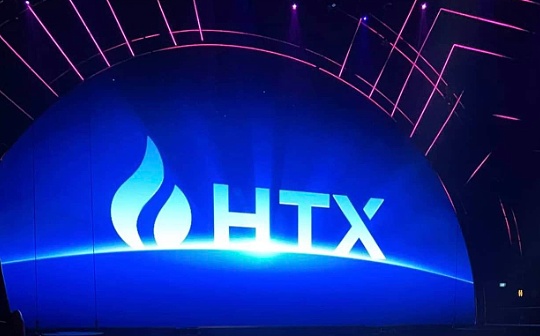
Author: Vitalik, founder of Ethereum; compiled by Deng Tong, Bitchain Vision
Recently, I’ve read (or rather, listened to audio) two major history books that introduce the 2010s Bitcoin Block Size Battle from two extremes:
Jonathan Beal’s “Block Size Battle” tells the story from the perspective of supporting small blocks;
Roger Weill and Steve Patterson’s “Hiding Bitcoin” tells the story from a supportive block perspective.

It’s fascinating to read these two history of events that I’ve experienced personally and even got involved in it to some extent.While I know most of the events that happened, and what both sides think about the nature of the conflict, there are still some interesting parts that I don’t know or completely forget, and it’s interesting to look at this situation with a whole new perspective.At that time, I was a “big obstructor”, although I was a pragmatic centrist obstructor, opposing extreme increases or absolute claims that the cost should never exceed zero significantly?Do I still support the views I held at the time?I look forward to finding out.
In Jonathan Bier’s narration, how do small blockers view block-sized wars?
The initial debate around the block size dispute revolved around a simple question: whether Bitcoin should be hard forked, increasing the block size limit from 1 MB at the time to a higher value to allow Bitcoin to process more transactions, thereby reducing costs, but at the cost of making the chain run nodes and verification more difficult and costly?

“[If the block size is larger], you will need a large data center to run the nodes, and you won’t be able to run anonymously” – this is a piece by Peter Todd who advocates keeping block sizes smallerKey arguments presented in the video.
Bill’s book gave me the impression that while small block proponents do care about this issue, tend to take a conservative approach, adding only a little block size to make sure it’s still easy to run the node, they’re more concerned about how to decide more generallyProtocol-level issues like this.In their opinion, changes to protocols (especially “hard forks”) should occur rarely and must be highly consensus among protocol users.
Bitcoin is not trying to compete with payment processors—there are already many of these processors.Instead, Bitcoin is trying to become something more unique and special: a brand new currency that is not controlled by central organizations and central banks.If Bitcoin starts to have a highly active governance structure (which will be necessary to deal with controversial block size parameter adjustments), or becomes susceptible to collaborative manipulation by miners, exchanges or other large companies, it will lose this foreverA valuable unique advantage.
In Bill’s view, the big blockers offend the small blockers the most, precisely because they often try to unite relatively few big players to legitimize the changes they want and drive the changes—and this goes with the small blockersThe view on how to manage it is incompatible.
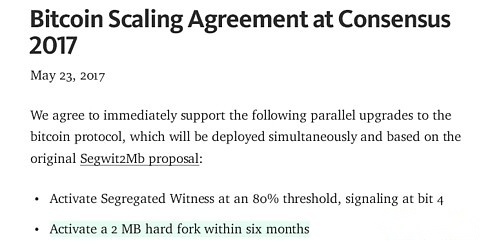
The New York Agreement was signed in 2017 by major Bitcoin exchanges, payment processors, miners and other companies.Small blockers see this as a key example of trying to transform Bitcoin from user domination to conglomerate domination.
In Roger Ver’s story, how do big blockers view the battle between block size?
Big block proponents often focus on a key underlying question: What should Bitcoin be?Should it be a store of value—digital gold, or a means of payment—digital cash?For them, from the beginning, everyone knew that the initial vision, and the vision that big block supporters all agreed, was digital cash.Even said this in the white paper!
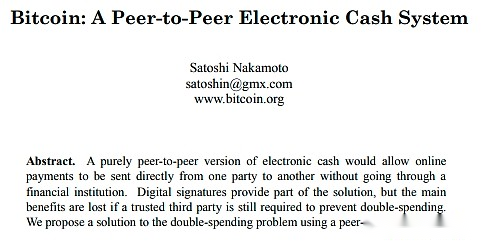
Supporters of large blocks also often quote two other things written by Satoshi Nakamoto:
-
The simplified payment verification section in the white paper, which talks about once the block becomes very large, individual users can use Merkle proof to verify whether their payment is included without verifying the entire chain.
-
The Bitcoin topic quotes a passage that advocates the gradual increase in block size by hard forks:

For them, the shift from focusing on digital cash to digital gold was a turning point that was unanimously recognized by a small group of closely-connected core developers who later believed that because they considered the issue and concluded internally, so they have the right to impose their own opinions on the entire project.
Small block proponents do provide solutions for how Bitcoin becomes both cash and gold—that is, Bitcoin becomes the “Layer 1” focused on becoming gold, and the “Layer 2” protocol built on Bitcoin (e.g.Lightning Network) offers cheap payments without using blockchain in every transaction.However, these solutions are very inadequate in practice, and Weir has used several chapters to criticize them deeply.For example, even if everyone turns to the Lightning Network, it will eventually need to increase the block size to attract hundreds of millions of users.Additionally, receiving tokens without trust in the Lightning Network requires having an online node, and to ensure that the tokens are not stolen, the chain needs to be checked once a week.Weir believes that these complexities will inevitably drive users to interact with the Lightning Network in a centralized way.
What are the main differences in their views?
Weir’s description of the debate is consistent with the description of the small block supporters: both parties agree that the small block supporters value the convenience of running nodes more, while the large block supporters value cheap transaction fees.They all acknowledge that there are reasonable differences in beliefs, and that differences are a key factor in the debate.
But Bill and Weir have very different descriptions of most deeper underlying layers.For Bill, the small block party represents users and opposes small but powerful miners and exchange groups who are trying to seize control of the blockchain for their own interests.Small blocks keep Bitcoin decentralized by ensuring that ordinary users can run nodes and verify blockchains.For Ville, the big block party represents users, opposing small but powerful venture capital firms (i.e. Blockstream) who claim to be high priests from the Layer 2 solutions needed to build a small block roadmapMake a profit.Large blocks keep Bitcoin decentralized by ensuring users can continue to afford on-chain transactions without relying on a centralized Layer 2 infrastructure.
In my opinion, the closest thing to the two sides “to reach an agreement on the terms of the debate” is that Bill’s book acknowledges that many large block supporters were kind-hearted and even admitted that they reviewed objections against forum moderators who support small blocksThere are legitimate dissatisfactions, but often criticize the incompetence of the large block, while Weir’s book prefers to blame malice and even conspiracy theories on small block supporters, but rarely criticizes their abilities.This echoes a common political metaphor that I have heard many times, namely, “the right thinks the left is naive, and the left thinks the right is evil.”
In my story, how do I view the dispute over block size?How do I view it today?

Room 77 is a restaurant in Berlin that accepts Bitcoin payments.It is the center of Bitcoin Kiez, a region of Berlin where a large number of restaurants accept Bitcoin.Unfortunately, the dream of Bitcoin payments has gradually shattered in the late stages of nearly a decade, and I think the increase in fees is the culprit.
When I personally experience the Bitcoin block size dispute, I usually stand on the side of the big blockers.My sympathy for the larger block is mainly focused on the following key points:
-
One of the key initial promises of Bitcoin is digital cash, and high fees may kill this use case.While the Layer 2 protocol can theoretically offer much lower fees, the entire concept has not been highly tested, and the small blockers promise that the small block roadmap is very irresponsible because they know how the Lightning Network performs in practiceVery few.Today, the practical experience of the Lightning Network makes pessimistic views more common.
-
I don’t believe in the “meta-level” story of small blocks.Small blockers often argue that “bitcoin should be controlled by users” and “users do not support large blocks” but are never willing to determine any particular way to define who is “user” or measure what they want.Large blockers secretly tried to propose at least three different ways of counting users: hash power, public statements from well-known companies and social media discourse, and small blockers condemn each.Large blockers don’t organize the New York Agreement because they like “cabals”; they organize the New York Agreement because small blockers insist that any controversial changes require “consensus” between “users”, and large blockersBlockers believe that only the major stakeholders sign a statement can truly do this.
-
Compared to the simple hard fork block size increase, the proposal to witness a slight increase in block size by the small block square is too complex.The small block square finally believed in the concept of “soft forks are good, hard forks are bad” (I strongly object to it) and designed methods to increase the size of the block to fit this rule, although Bill admitted that the complexity was so severe that manyLarge blockers cannot understand the proposal.I think small blockers are not just “supporting prudence”, they arbitrarily choose different types of prudence, choosing one (no hard fork) and sacrificing the other (maintaining clean and simple code and specifications) because this fits theirAgenda.Ultimately, big block proponents also abandoned the idea of “clean and simple” in favor of Bitcoin Unlimited’s adaptive block size increase, which Bill (righteously) criticized fiercely for their decision.
-
Small block proponents do take very uncool censorship on social media to impose their opinions, which ultimately led to theirmos’ infamous rhetoric “If 90% of /r/Bitcoin users think these policies are intolerable, then I want these 90% of /r/Bitcoin users to leave.”

Even relatively modest posts that advocate large blocks are often deleted.Use custom CSS to make these deleted posts invisible.
Weir’s book focuses on points one and four, and also on points three, as well as the economically motivated malfeasance theory—that is, small blockers have set up a company called Blockstream, which will be in BitcoinConstruct the Layer 2 protocol and advocate an ideology, i.e.Bitcoin Layer 1 should remain paralyzed, making these commercial Layer 2 networks a necessary one.Ver didn’t pay much attention to the idea of how Bitcoin should be governed, because for him, the answer to “Bitcoin is governed by miners” is already satisfactory.At this point, I do not agree with either party: I find it unreasonable to be vague “we reject the truly defined user consensus” and extreme “miners should control everything because they have a consistent incentive”of.
Meanwhile, I remember that at some key points, I was very frustrated with the big blockers, and these views are exactly the same as Bier’s book.One of the worst cases (both me and Bier think) is that large blockers are never willing to reach any realistic limiting principle on block size.A common view is that “block size is determined by the market” – which means that miners should create blocks according to their own wishes, and other miners can choose to accept or reject these blocks.I strongly oppose this view and point out that this mechanism is the market, which is a huge extension of the concept of “market”.Ultimately, when large blockers split into their own standalone chains (Bitcoin Cash), they eventually abandoned this view and added a 32 MB block size limit.
At the time, I did have a principled reasoning method on how to determine the block size limit.Quote an article from 2018:
Bitcoin tends to maximize the cost of reading a blockchain at the expense of as little predictability as possible for writing to a blockchain. It can be predicted that the results of the previous metric are very healthy, while the results of the next metric are very healthy.The result is very bad.Ethereum and its current governance model tend to be moderate predictability of both.
I later repeated this point in a 2022 tweet.Essentially, this concept is:We should strike a balance between increasing the cost of writing a chain (i.e. transaction fees) and the cost of reading a chain (i.e. software requirements of the node).Ideally, if the demand for blockchain is increased by 100 times, we should half the pain, increase the block size by 10 times and increase the fee by 10 times (the demand elasticity of transaction fees is close enough to 1, which in practice isfeasible).
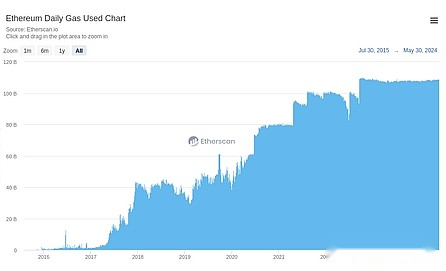
Ethereum actually ended up taking a medium-blocking approach: since its launch in 2015, the chain’s capacity has increased by about 5.3 times (perhaps 7 times if you count calldata repricing and blobs), while the fees are almostZero increases to a significant but not too high level.
However, this compromise-oriented (or “concave”) approach has never become popular among the two factions; perhaps one thinks it is too “centralized” and the other thinks it is too “indecisive”.I think large blockers are more responsible in this regard than small blockers; small blockers are open to moderate increase in block size at the beginning (such as Adam Back’s 2/4/8 plan), while large blockers do notWilling to compromise, they quickly changed from advocating the increase in block size to a specific larger number at once to advocating the general idea that almost any non-trivial restriction on block size is illegal.
Large blockers have also begun to argue that miners should be in charge of Bitcoin—a concept that Bill has effectively criticized, noting that if miners try to change the rules of the protocol to do things other than increasing the size of the block—such as giving themselves moreMore rewards – they may soon give up their opinions.
In Bill’s book, a big criticism of big block supporters is their repeated incompetence.Bitcoin Classic’s code is not well written, Bitcoin Unlimited is too complex and has not provided clearance protection for a long time, not seeming to realize that such choices will greatly harm their chances of success (!!), and that they have serioussecurity vulnerability.They clamored for the need for multiple Bitcoin software implementations – I agree with this principle, and Ethereum adopted it – but their “alternative client” is really just a fork of Bitcoin Core, with only a few lines of code being changed to implement itIncrease in block size.In Bill’s description, their repeated out-of-compliance in code and economy eventually led to an increasing number of supporters leaving them over time.The main large block supporters were further discredited by Craig Wright’s deceptive claim to be Satoshi.

Craig Wright, a liar who pretends to be Satoshi Nakamoto.He often uses legal threats to dispel criticism, which is why my fork is the largest online copy in the Cult of Craig repository that records evidence that he is a fraud.Unfortunately, many large block users are fooled by Craig’s antics because Craig follows the big block party line and says what big block users want to hear.
Overall, after reading these two books, I found myself agreeing with Vill more on macro issues, but more on Bill’s point of view in specific details.In my opinion,Large block supporters are right on the core issue that blocks need to be bigger, and it is best to do this with a simple and clean hard fork described by Satoshi Nakamoto, but small block supporters commit embarrassing techniquesThere are much fewer mistakes, and there are fewer cases where they lead to ridiculous results if you try to push their position toward logical conclusions.
The battle between block size is a one-sided capability trap
The combined impression I get from reading these two books is a political tragedy, which I feel like I have seen repeatedly in various contexts, including cryptocurrencies, corporate and national politics:
One side monopolizes all capable people, but uses their power to promote narrow and biased views; the other side correctly recognizes that some things are wrong, but focuses on opposition and fails to develop technical capabilities for independent execution.
In many such cases, the first group is criticized as dictatorial, but when you ask its supporters (usually many) why it supports it, their answer is that the other party only knows how to complain; if they do get power,They will fail completely within a few days.
This is not the opposition’s fault in some ways: it is difficult to be good at executing without an execution platform and gaining experience.But in the block size debate, the big block side seems to be largely unaware of the necessity of execution capabilities—they think they can only win by making the right judgment on the block size issue.The big blockers ended up paying a heavy price for their focus on opposition rather than building in multiple ways: Even if they split into their own chains with bitcoin cash, they ended up splitting twice more before the community finally stabilized.
I call this problem a one-sided capability trap.This seems like a fundamental problem for anyone trying to build a political entity, project or community that they want to be democratic or diversified.Smart people want to work with other smart people.If two different groups are roughly equal, people will tend toward groups that are more in line with their values, and the balance will stabilize.But if you go too far in one direction, you turn to another balance and it seems difficult to reverse it.To some extent, the unilateral capability trap can be mitigated as long as the opposition is aware of the existence of the problem and they must consciously build their abilities.Often, the opposition movement hasn’t even reached this point.But sometimes it is not enough to just recognize the problem.We will benefit greatly if there are stronger and more in-depth ways to prevent and escape the unilateral ability trap.
Reduce conflicts and increase technology
There is a very obvious omission in these two books that impressed me: the word “ZK-SNARK” appears in zero times in both books.There aren’t many excuses for this: Even by the mid-2010s, ZK-SNARK and its potential to revolutionize scalability (and privacy) were well known.Zcash was launched in October 2016.Gregory Maxwell explored the scalability impact of ZK-SNARK in 2013, but they didn’t seem to be taken into account at all when discussing Bitcoin’s future roadmap.
The ultimate way to alleviate tensions is not compromise, but new technology: discovering fundamentally new ways while providing both sides with more of what they want.We have seen several such examples in Ethereum.Several examples that come to mind are:
-
Justin Drake promotes the adoption of BLS aggregation, allowing Ethereum’s proof of stake to handle more validators, reducing the minimum stake balance from 1500 to 32 with little negative impact.Recently, signature mergers are expected to further advance this goal.
-
EIP-7702 achieves the goal of ERC-3074 and has significant forward compatibility with smart contract wallets, thus helping to alleviate long-standing controversy.
-
Multidimensional gas, starting with its implementation of blobs, has helped to improve Ethereum’s ability to save aggregated data without increasing the size of worst-case blocks, minimizing security risks.
When the ecosystem stops accepting new technologies, it inevitably stagnates, and becomes more controversial: The political debate between “I get 10 apples” and “You get 10 apples” is essentially more “I” than “IThe debate between Give Up 10 Apples and “You Give Up 10 Apples” has caused much less conflict.Loss is more painful than gains, and people are more willing to “break” their common political commons to avoid losses.That’s a key reason why I feel uncomfortable with the idea of going to grow and the idea of ”we can’t use technical solutions to solve social problems”: There are quite good reasons to believe, fighting for who wins more than scramblesWhoever loses less is indeed more beneficial to social harmony.
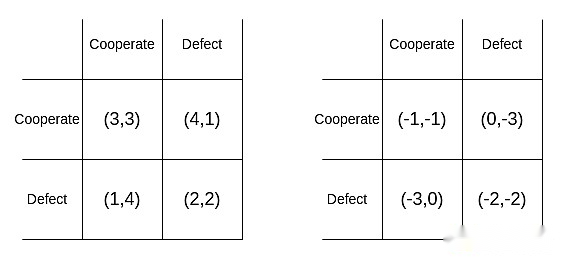
From economic theory, there is no difference between the two dilemmas: the game on the right can be seen as the game on the left plus a separate (irrelevant) step in which both sides lose four regardless of how the player actspoint.But in human psychology, the two games may be very different.
A key question for Bitcoin’s future development is whether Bitcoin can become a technologically leading ecosystem.The development of Inscriptions and later BitVM created new possibilities for Layer 2, improving what you can do with Lightning Networks.Hopefully Udi Wertheimer’s theory is correct, that ETH’s acquisition of ETFs means the demise of Saylorism, and a re-understanding of the need for technical improvements in Bitcoin.
Why do I care about this?
I care about the success and failure of researching Bitcoin, not because I want to devalue Bitcoin to improve Ethereum; in fact, as someone who loves to try to understand social and political issues, one of the characteristics of Bitcoin is that it is in sociologyIt’s so complex that its internal debate and division is so rich and fascinating that you can write two books on it.I care about analyzing these issues because Ethereum and other digital (even physical) communities I care about can learn a lot from understanding what is going on, what goes well, and what can be done better.
Ethereum’s focus on client diversity stems from the failure of observing Bitcoin’s only one client team.Its Layer 2 version stems from understanding how the limitations of Bitcoin lead to the limitations of what kind of Layer 2 with trust attributes can be built on it.More generally, Ethereum’s explicit attempts to cultivate diversified ecosystems are largely aimed at avoiding unilateral capability traps.
Another example that comes to mind is network state movement.This is a new strategy for digital division that allows communities with consistent values to gain a degree of independence from mainstream society and build their own vision for the future of culture and technology.But the experience of Bitcoin Cash (after fork) shows that movements organized around fork solving problems have a common pattern of failure: they end up splitting time and time again and never really collaborating.The lessons learned from Bitcoin Cash go far beyond the value of Bitcoin Cash itself.Zuzalu is in some way an attempt to drive change in this direction myself.
I suggest reading Bill’s Block Size War and Weir’s Hijacking Bitcoin to learn about one of the decisive moments in Bitcoin’s history.In particular, I recommend having this mindset when reading these two books: It’s not just about Bitcoin—instead, it’s the first real high-risk civil war in the “digital country” and these experiences for us inOther digital countries to be built in the coming decades provide important lessons.

